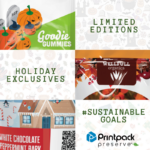In 2024, expect an era of heightened awareness and evolving lifestyles. As health, sustainability, convenience, and technology take center stage, the correlation between consumer trends and packaging is becoming increasingly pronounced. Find out how your brand can be guided by insights and gear up to take part in the new year’s trends:
Holistic Focus on Wellness
The landscape of wellness in 2024 is marked by a profound shift as consumers embrace a holistic approach, prioritizing both physical and mental well-being. A surge in accessible health information has empowered individuals to curate personalized health routines, ushering in a new era of self-care and informed decision making.
Promoting well-being will be important as individuals seek to prolong their healthy years and challenge the societal stigmas surrounding aging issues. By 2030, 1 in 6 people in the world will be aged 60 years or older. Gen Xers will be at the forefront of the wellness movement as they enter middle age. However, the emphasis on prioritizing health resonates across generations.
The IFIC finds that 74% of consumers believe that food and beverage choices are interconnected with mental and emotional well-being. Therefore, consumers are now more discerning, delving into ingredient lists, nutritional content, and production methods to make choices aligned with their health goals.
How Your Brand Can Take Part:
Functional ingredients that enhance wellness can be called out on-pack and highlighted to grab the attention of consumers. Easy-to-open packaging for an aging population along with products and formulations that target issues such as heart health and blood sugar will gain traction. The same goes for healthy and better-for-you (BFY) snacks that offer benefits for brain function, sleep, and weight loss. These foods can place wellness goals front and center, or even offer smaller pack sizes for portion control, such as salty snack packs
High Expectations for Brand Sustainability
The intensifying climate crisis has cast a shadow over daily decisions. Individuals are increasingly seeking sustainable alternatives to minimize their environmental footprint. Consumers now assume and, indeed, expect that CPG brands are committed to operating sustainably. This expectation is not a fleeting trend; it has evolved into a demand for transparency, responsibility, and measurable action.
In the US, 1/3 of shoppers want to see a standardized labeling system for sustainability information, and 59% believe many companies are just pretending to be sustainable. This expectation isn’t limited solely to recycling options. It applies to local sourcing and manufacturing as well. 50% of US adults expect companies to provide information on their overall environmental impacts, while 47% expect companies to manufacture entirely in the USA.
Implementing circular economy initiatives in e-commerce is also challenging, mainly due to consumers lacking effective ways to recycle or return packaging. In 2024, the prevalence of digitally convenient features and deposit facilities is expected to rise, providing solutions to overcome these challenges.
How Your Brand Can Take Part:
If your brand is future-oriented and meeting these consumer expectations, choose a trusted and experienced sustainability partner to guide these vital packaging decisions. To address these sustainability trends, use on-pack labeling to explain your environmentally-responsible initiatives. This can take the form of clear and simple language, using pre-qualified sustainable structures with recognizable symbols like How2Recycle, or including direct recycling instructions for PE structures. Encourage consumers to participate in curbside recycling or store drop-off. Market your company sustainability goals and give consumers ways to learn more.
Seeking Connection and Comfort during Uncertain Times
As was observed during the COVID 19 pandemic, individuals grappling with stress and uncertainty stemming from economic challenges and crises around the world turn to food and beverages as their source of comfort.
The current disruption caused by inflation emphasizes the necessity for brands to prioritize building or enhancing brand equity. Consumers will likely look to the center of the store for solutions that deliver convenience and value. 53% of global consumers are actively trying to reduce spending on food and drink. Many are switching to private label store brands due to shifting perceived value of national brands.
Individuals are also grappling with the erosion of meaningful relationships and connections. 46% of US Consumers say that spending time in-person with friends and family is a high priority for them, and 62% prefer to spend their free time with friends/family, as opposed to alone.
How Your Brand Can Take Part:
Brands play a pivotal role in shaping the self-care industry by offering products that cocoon users in comfort. However, the current challenge is for brands to encourage individuals to step out of this cocoon and re-engage with the social world which can enhance consumers’ well-being. On packaging, brands can highlight these values front and center and create connections through smart packaging methods like QR codes, commonly used on products associated with enjoyment like confectionery. Lastly, brands can maintain loyalty by offering consumers lower priced options and venturing into new product categories under the established brand name. 68% of shoppers report spending more on groceries than one year ago, and many are shopping at value chain and club stores to offset costs – creating an opportunity for brands to develop their products to meet consumers’ needs at the right value.
Embracing a New Age of Intelligence
Technology is revolutionizing the way we approach meals, simplifying everything from planning and shopping to cooking and dining. Cutting-edge tools like artificial intelligence (AI) and augmented reality (AR) are empowering consumers to strike the perfect balance between automating routine tasks like meal planning, shopping, cooking, and even eating, while still allowing room for creative culinary expressions. These tools also cut out the need for cooking instructions, reclaiming valuable packaging real estate that brands can use to tell their stories. Studies reveal that 47% of US consumers agree AI tools such as ChatGPT or Tidy.ai will make daily chores easier and 48% agree that AI makes it easier to shop for products online.
How Your Brand Can Take Part:
Brands can use connected packaging, augmented reality and AI-based platforms to reach tech-savvy audiences. Marketing will shift from targeted ads to an evolved form of product placement. Artificial intelligence, augmented reality, and other recipe generators will be able to suggest specific brands for personalized meal planning.
CPG companies can also employ advanced AI techniques for predictive analysis. By leveraging vast datasets, these companies will gain insights into consumer behavior, preferences, and trends, allowing for more accurate predictions in the ever-evolving market. Brands like Vivi Kola are even using AI for product development based on changing consumer needs.
Get Inspired! Bring these trend ideas and recommendations to your team’s brainstorming sessions for the new year:
- Call out functional ingredients on-pack and highlight formulations that target aging issues like heart health and blood sugar
- Create easy-to-open packaging for an aging population
- Market healthy and better for you (BFY) snacks that offer benefits for brain function, sleep, and weight loss and smaller pack sizes for portion control
- Use on-pack sustainability labeling with clear and simple language, or use pre-qualified sustainable structures
- Include simple instructions for curbside recyclability or store drop-off to encourage consumer participation in the circular economy
- Highlight the value of social connections front and center, or create those connections through smart packaging methods
- Enhance brand equity – give consumers a lower price option by venturing into new product categories
- Use AI and AR to predict consumer behavior and personalize consumer experience
Packaging Insights Researched and Provided by: Nicole Karamallakis, Printpack Customer and Consumer Insight Specialist
Curious to read more about prior year’s packaging trends? Head here:
- 2023 Packaging Trends and Insights
- 2022 Packaging Trends and Insights
- 2021 Packaging Trends and Insights
*********
About Printpack
Printpack is a leading manufacturer of flexible and specialty rigid packaging with over 60 years of experience helping brands improve retail visibility, heighten brand awareness, and capture market share. Printpack combines unique insights into consumer preference with advanced technological capabilities in order to convert packaging concepts into reality. Headquartered in Atlanta, GA, Printpack is a privately held company that believes cooperation and integrity result in sustainable innovation.



